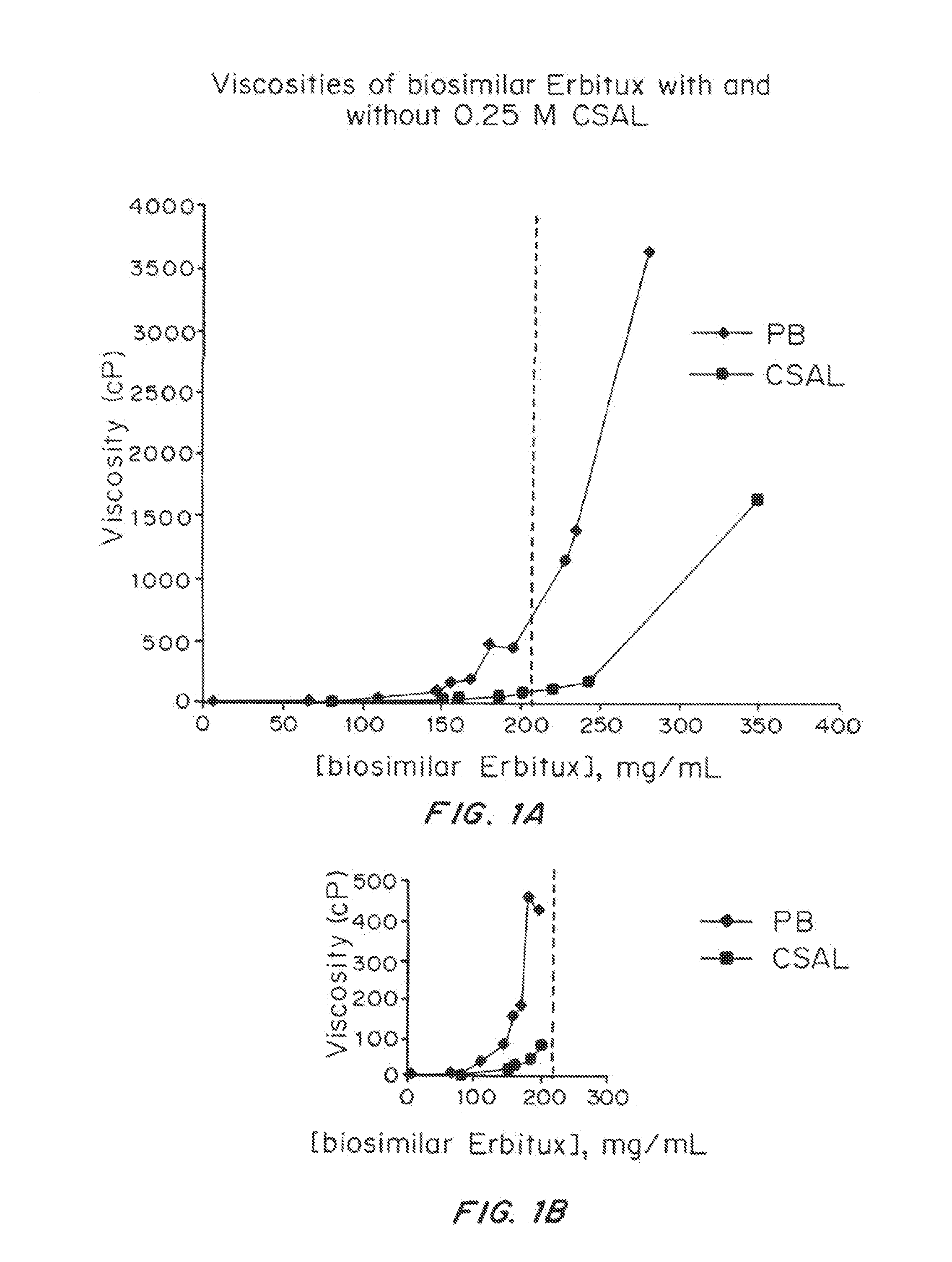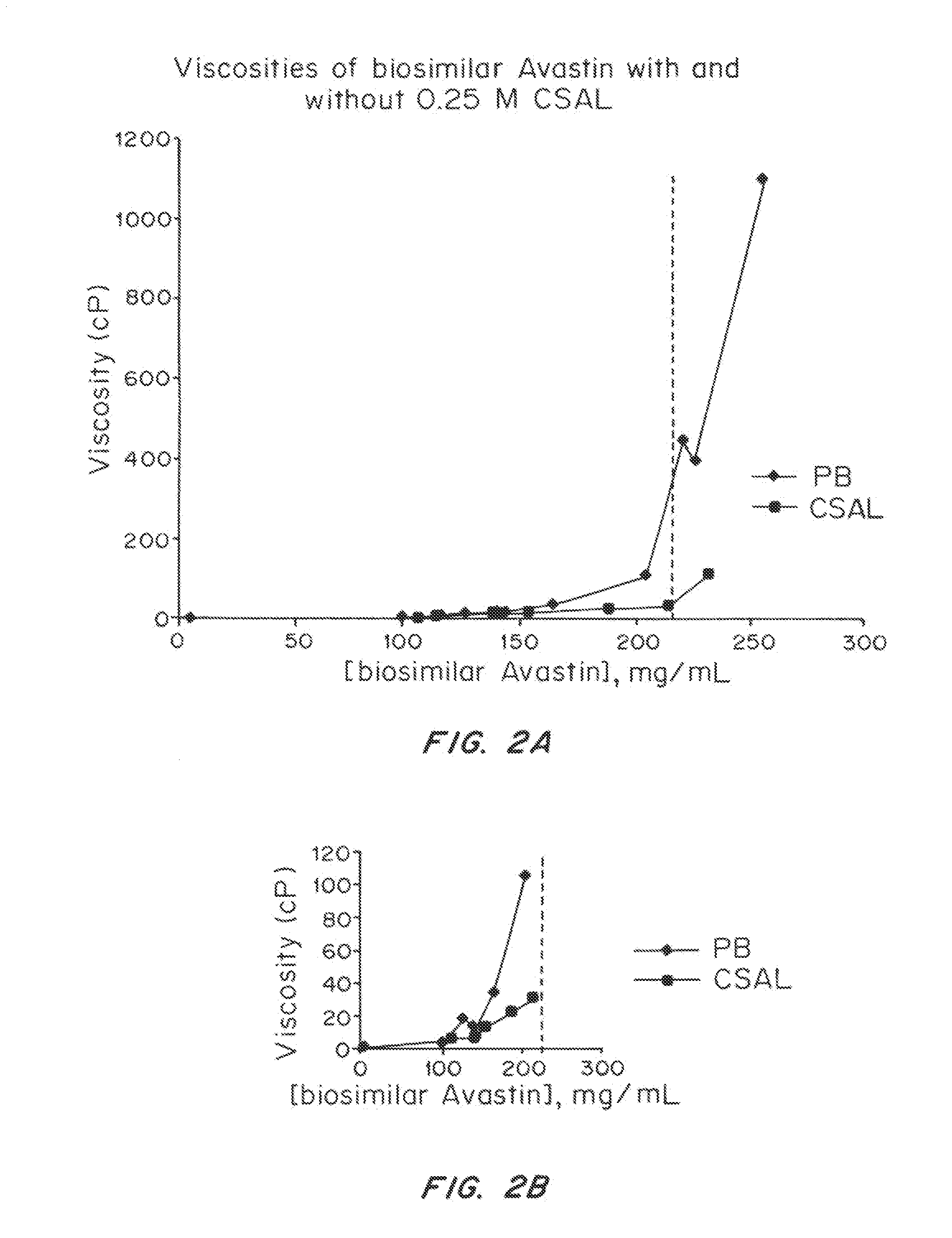Liquid protein formulations containing viscosity-lowering agents
a liquid protein and viscosity-lowering agent technology, applied in the field of injectable low viscosity pharmaceutical formulations, can solve the problems of difficult to achieve manufacturing, storage, and difficulty in achieving chemical and/or physical stability, and achieve the effects of facilitating and/or accelerating reconstitution, reducing the viscosity of protein solutions, and facilitating processing
- Summary
- Abstract
- Description
- Claims
- Application Information
AI Technical Summary
Benefits of technology
Problems solved by technology
Method used
Image
Examples
example 1
Effect of a Viscosity-Lowering Agent, Camphorsulfonic Acid Lysine (CSAL), on the Viscosity of Solutions of Biosimilar ERBITUX®
[0344]Materials and Methods
[0345]A commercially-obtained biosimilar ERBITUX® (100-400 mg) containing pharmaceutical excipients (Polysorbate 80, phosphate buffer, and NaCl) was purified. First, Polysorbate 80 was removed using DETERGENT-OUT® TWEEN® Medi Columns (G-Biosciences). Next, the resulting solutions were extensively buffer-exchanged into 20 mM sodium phosphate buffer (PB; pH 7.0) or 20 mM CSAL (pH 7.0) and concentrated to a final volume of less than 10 mL on Jumbosep centrifugal concentrators (Pall Corp.). The collected protein solution was freeze-dried. The dried protein cakes, containing protein and buffer salts or agent, were reconstituted to a final volume of 0.15-1.3 mL. These samples were reconstituted using additional PB (pH 7.0) or CSAL (pH 7.0) sufficient to bring the final concentration of PB or CSAL to 0.25 M. The final concentration of mAb ...
example 2
Viscosity-Lowering Effect of a Viscosity-Lowering Agent, Camphorsulfonic Acid Lysine (CSAL), as a Function of Concentration of Biosimilar AVASTIN®
[0348]Materials and Methods
[0349]A biosimilar AVASTIN® obtained commercially and containing pharmaceutical excipients (Polysorbate 20, phosphate buffer, citrate buffer, mannitol, and NaCl) was purified, buffer exchanged, concentrated, dried, reconstituted, and analyzed as described in Example 1 above (using the extinction coefficient of 1.7 L / g·cm at 280 nm). The protein was formulated to contain either 0.25 M phosphate buffer or 0.25 M CSAL.
[0350]Results
[0351]FIGS. 2A and 2B depict the viscosity of aqueous mAb solutions as a function of mAb concentration in aqueous buffered solution and with CSAL. The viscosity of biosimilar AVASTIN® in aqueous phosphate buffer and in the presence of CSAL increases exponentially with increasing concentration; however, as in the case of biosimilar ERBITUX®, this increase is much less marked for the CSAL-co...
example 3
Viscosity-Lowering Effect as a Function of CSAL Concentration for Aqueous Solutions of Biosimilar ERBITUX®
[0352]Materials and Methods
[0353]Samples were purified, buffer exchanged, concentrated, dried, reconstituted, and analyzed similarly to Example 1 above. The final concentration of CSAL upon reconstitution in an aqueous CSAL solution ranged from 0.25 M to 0.50 M.
[0354]Results
[0355]Table 1 shows the viscosity of solutions of biosimilar ERBITUX® formulated in 0.25 M phosphate buffer (no CSAL as a control) and with varying concentrations of CSAL. The viscosity-lowering effect of CSAL is seen to rise from 8.4- to 12.1-fold with increasing viscosity-lowering agent concentration. The data in Table 1 show that the higher the concentration of CSAL, the greater the viscosity-lowering effect, at least within the agent concentration range tested.
TABLE 1Viscosities of aqueous solutions of biosimilar ERBITUX ®(155 ± 5 mg / mL, pH 7.0) in the presence of differentconcentrations of CSAL at 25° C....
PUM
| Property | Measurement | Unit |
|---|---|---|
| absolute viscosity | aaaaa | aaaaa |
| molecular weight | aaaaa | aaaaa |
| molecular weight | aaaaa | aaaaa |
Abstract
Description
Claims
Application Information
 Login to View More
Login to View More - R&D
- Intellectual Property
- Life Sciences
- Materials
- Tech Scout
- Unparalleled Data Quality
- Higher Quality Content
- 60% Fewer Hallucinations
Browse by: Latest US Patents, China's latest patents, Technical Efficacy Thesaurus, Application Domain, Technology Topic, Popular Technical Reports.
© 2025 PatSnap. All rights reserved.Legal|Privacy policy|Modern Slavery Act Transparency Statement|Sitemap|About US| Contact US: help@patsnap.com



